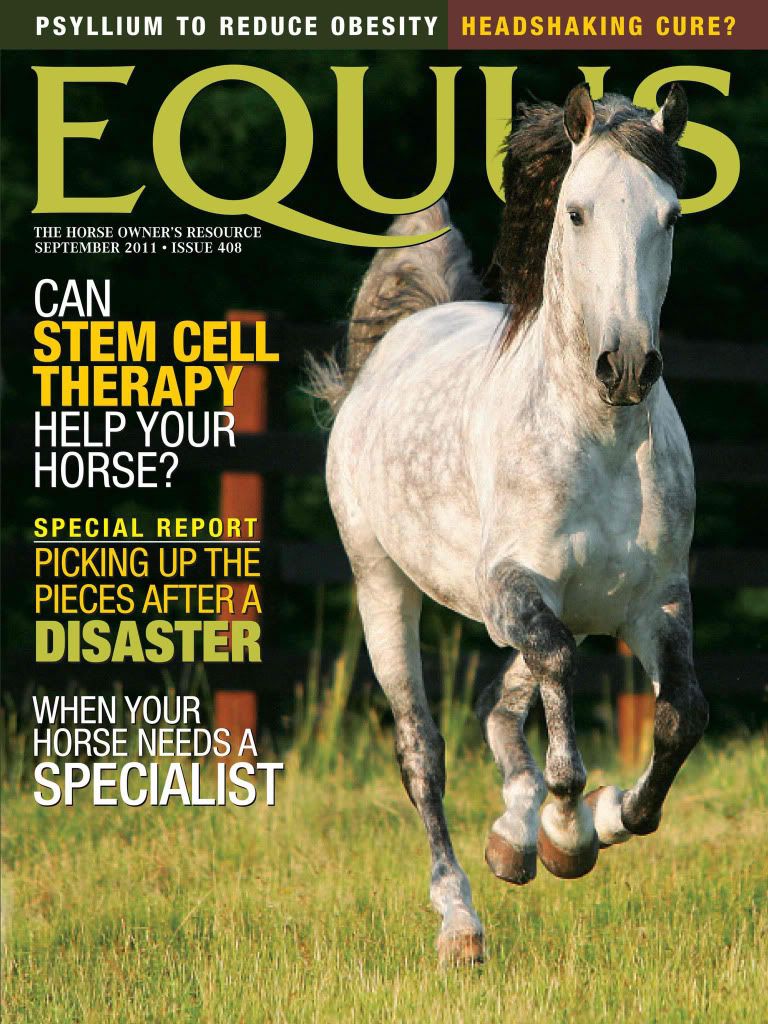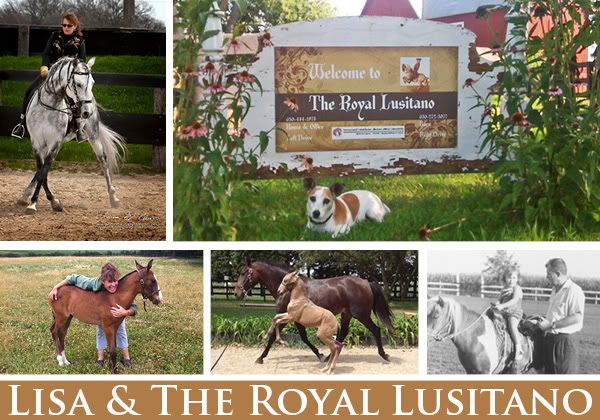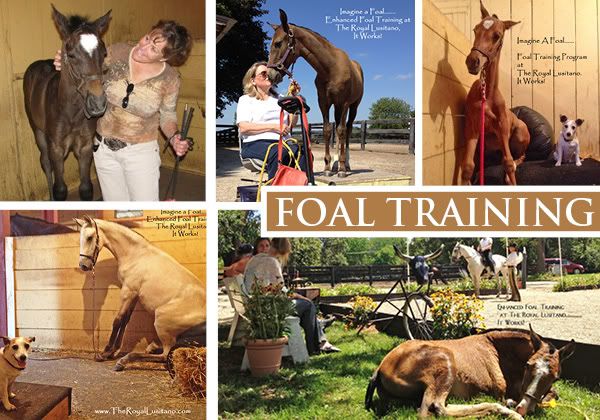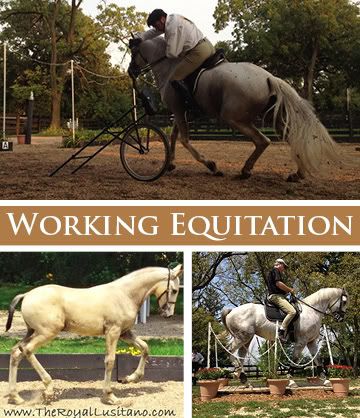EQUI PARTNER PROFESSIONAL
Lisa Diersen~The Royal Lusitano
Center For Healing Arts
Saint Charles, Illinois
 |
| Lisa's Stallion~Urano VO 9844(P) |
Our mission at The Royal Lusitano is to help make these amazing horses available to anyone who is interested in finding their lifelong equine dancing partner. We are working to give the American Lusitano market a place to find the horse of their dreams without having to travel out of the country to find them.
Tell us about your beginning with horses
My very favorite photo is the one of me and my Dad. I was maybe three or four years old  at the time. I was riding a pony named "Trigger". The addiction to horses had already begun! For as long as I can remember, I have always had horses, real or otherwise in my life. My first "real" horse was a POA named Freckles, who was a gift to my sister and myself when I was 15 years old. I began the work to support the horse phase! Don't we all know something about that.
at the time. I was riding a pony named "Trigger". The addiction to horses had already begun! For as long as I can remember, I have always had horses, real or otherwise in my life. My first "real" horse was a POA named Freckles, who was a gift to my sister and myself when I was 15 years old. I began the work to support the horse phase! Don't we all know something about that.
How did you get involved with Lusitanos and development of the Royal Lusitano?
My love for the Lusitano breed began with a trip to New York in the early 90's with a group of friends to see a show that was here from France named "Zingaro" directed by an elusive French horseman named Bartabas! I had seen the Lipizzans before when I was younger and loved how they could fly. Only after I saw the magical union between horse and rider as they were dancing in front of me, did I think that even I might have the ability to make this kind of beautiful poetry with my horses. Bartabas brought a stunning demonstration of Horsemanship and Poetry to the equestrian stage. The vision of that has never left my mind. I went to Versailles in France to the Riding Academy to watch Bartibas and his students perform on cream colored Lusitanos. I was a goner.
Then enter Cavalia with Magali Delgado and Ferderic Pignon, again breathtaking poetry and magic in the center ring. Dressage out of the box! Truly dancing with your horse. My riding life was changed forever. The magical horse that ties all of these equine poets together is the Lusitano! The masters of Equine Dance, Klaus Ferdinand Hempfling, Dominique Barbier even Buck Brannaman have all influenced my life with horses and changed how I think and feel around them.
Tell us about your Breeding program, including the Enhanced Foal Training Program
& "Imagine a Foal"
 Our breeding program is simple: To improve upon the breed with each new generation of foals. Matching only the finest quality mares with the top quality stallions, breeding to improve upon what you already have. The Mares are the most important part of the program. The foals learn so much from their Dams from the moment they are born until they are weaned.
Our breeding program is simple: To improve upon the breed with each new generation of foals. Matching only the finest quality mares with the top quality stallions, breeding to improve upon what you already have. The Mares are the most important part of the program. The foals learn so much from their Dams from the moment they are born until they are weaned.
Our foundation breeding mares are imported from Brazil but the ones who are not imported have been bred here at The Royal Lusitano from our foundation stock. Our breeding stallions are chosen very carefully to improve upon the next generation of foals.
I met a very interesting couple a few years ago, Allen Pouge and his partner Susan De Laurentis, at the International Andalusian Lusitano Horse Association (IALHA) Horse Show in Dallas/Fort Worth Texas. They introduced me to the wonderful world of Enhanced Foal Training. I watched in awe as they showed me the way they start their foals, using Dr. Millers "Imprinting" techniques. Their own behavior modification program they developed was full "Hands-On" approach to foal starting. I couldn't believe what I was seeing! Baby horses, just weeks old, confidently walking out of the stall without their mothers to stand on a platform to be groomed and have their feet cleaned with no stress! Wow, I wanted to start right away in the spring with our next crop of foals! Imagine a foal that has great ground manners, loads into the trailer (with or without mom) stands for their bath, clipping, the vet or farrier, without any stress or fear at just one or two months old!
This training allows you to build a level of trust and closeness with the young horse, starting right after they are born. The results are amazing. The training sets up the foundation for a lifelong partnership with their human "Herd", building trust and confidence in the young horse in a way that I had not ever seen before. Starting at the beginning of the horses' life to give them basic skills to become confident partners. Wanting to provide the most positive start for our foals that I could, I began a program that we now call "Imagine a Foal" here at The Royal Lusitano.
Tell us about the new sport of Working Equitation in America

Working Equitation is a BLAST and everyone who tries it, loves it! It allows every rider from English, Western, Dressage, Portuguese to Spanish to compete in the same classes on a level playing field. All breeds of horses are welcome! Although, I think this is the sport that the functional Lusitano horse excels at. Once the sport takes hold in this country, everyone else will see how well this breed is suited for this sport! This is a sport that young and old riders alike can compete in. We hope the American youth can embrace this sport and understand how much fun they can have riding the correct way. You can't excel at this sport without great basic horsemanship skills. We could have a chance to compete on the international playing field! United States Pony Club and 4-H clubs should give it a try!
Working Equitation was created for promoting the different types of equitation techniques developed in countries that use the riding horse to work in the fields, on farms, and with livestock. The goal of Working Equitation is to preserve not only this type of equitation but also the cultural traditions of each country and their horses.
The four founding countries of Working Equitation were Portugal, Spain, France, and Italy. Now this discipline is practiced in many countries like Sweden, Germany, United Kingdom, Brazil, and now in the United States! Each country has its own rules for its National levels but the rules for International competitions are the same for all countries. The USA WE rules were created for our country's riders along with Internationally accepted rules and input from the World Association of Working Equitation.
Visit her website at